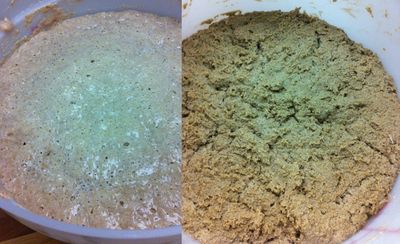This post is the third in a series about sourdough culture in bread baking. It all started with an overview called What is Sourdough and went on to discussing those things that contribute to great flavour in sourdough bread. Now we'll wrap things up and show how you can control the flavour in your sourdoughs.
I love bread bakeries. I love them so much I should have a bumper sticker that says "I Brake for Real Bread." Whenever I stop at a new bakery I always buy a sourdough loaf if they make a sourdough (not many do.) I'm always amazed at how remarkably different a 'sourdough loaf' can taste depending on the bakery.
How is that possible? If the ingredients are the same (flour, water, salt and possibly some extra yeast) why doesn't the bread taste the same? It comes down to how the baker keeps her starter.
This is the third in a series of articles that try to answer the question 'What is Sourdough?' In the first article, I talked about the main actors in a robust sourdough culture (enzymes, yeast and lactic acid bacteria.) The second article described the fermentation process and the components of sourdough flavour (glucose from flour, lactic acid and acetic acid.) Now that we have the building blocks, let's talk about how the baker can manipulate fermentation to get the flavour profile she desires.

The wheat starter on the left is very liquid (100% hydration) , like thick pancake batter. The rye starter on the right is thicker (80% hydration), like drying concrete (?!)
There are three main variables I have at my disposal:
Temperature: I can keep my starter relatively warm (at room temperature or slightly warmer, say between 73F - 78F), so fermentation is very active. Lots of enzyme activity creating glucose. Lots of activity among the lactic acid bacteria creating lactic acid (think 'yogurty tang'), at least until the starter runs out of food (which will happen quickly due to the high activity.
Alternatively, I can keep my starter very cool, refrigerated even, for long periods of time. This slows fermentation and creates a good environment for acetic acid (think 'vinegar') creation.
Hydration: This refers to the amount of water in the starter. I could keep my starter very wet, like a thick pancake batter. Or, I could mix a very stiff starter, like a stiff pizza dough.
More water = more active fermentation (more lactic acid created). Less water = less active fermentation (more acetic acid creation.)
Amount of Available Food: This refers to how much fresh flour is made available to the starter culture for the enzymes to turn into sugar and keep fermentation happening. I think of how often the starter is refreshed (once, twice or three times daily.)
If I feed my starter once a day, I will generally get a more 'sour' starter than if I feed it twice or three times per day. That's because the starter will run out of food and oxygen quicker, creating a great environment for acetic acid production, until such time as I feed the starter again.
With these building blocks, let's look at two examples:
-
At Orange Boot Bakery, I like a mild sourdough, with a fresh wheaty taste and just a tiny hint of a tang at the finish (when you swallow.) So I keep my wheat starter wet, like a thick pancake batter to produce more lactic acid and less acetic acid. I feed it twice every day to make sure the starter has lots of food to keep actively fermenting. And I keep it out at room temperature (ideally, at between 73F and 75F.)
-
my hero Nancy Rubiliak, former owner of Tree Stone Bakery in Edmonton, preferred her sourdough to have a more pronounced tangy 'bite.' So she mixed her starter stiffer than I do and kept it for long periods in her cool basement, while still feeding it twice daily. These changes contributed to more acetic acid production and a more 'sour' finish. BUT, it should be stressed, Nancy made incredibly tasty bread! It just tasted different than what I make.
When I attended the San Francisico Baking Institute in 2008 we took this to the limit, making three different white sourdough loaves from the same flour, the same water and the same salt. The difference? We used a range of starters, from stiff, cool and rarely fed to warm, liquid and often fed. The result? As you have probably guessed by now, we had everything from crusty, sour loaves (aka 'San Francisco Style') to light, airy, mild (still crusty) loaves, which maybe one day will be known as 'Orange Boot Style.'
So there you have it. Once you understand what goes on during fermentation and how you can use feeding times, temperature and hydration to control fermentation and flavour, you can create a sourdough loaf that meets YOUR idea of what 'proper bread' should taste like.
Happy Baking!
I hope you enjoyed this series on Sourdough baking. Are you making sourdoughs at home? What's your starter like? Any other questions? Let me know in the comments!
[Updated on June 11 to get Nancy's process right. Thanks for the reminder, Nancy!]